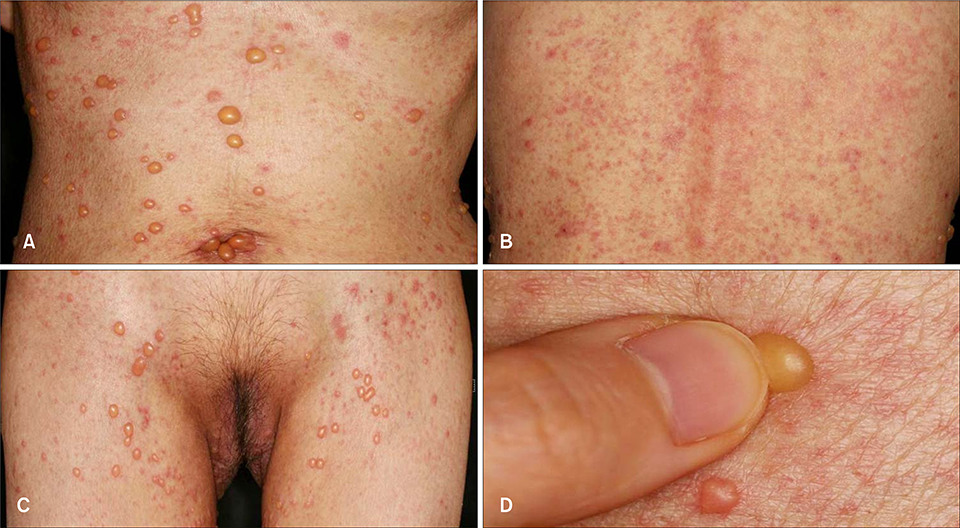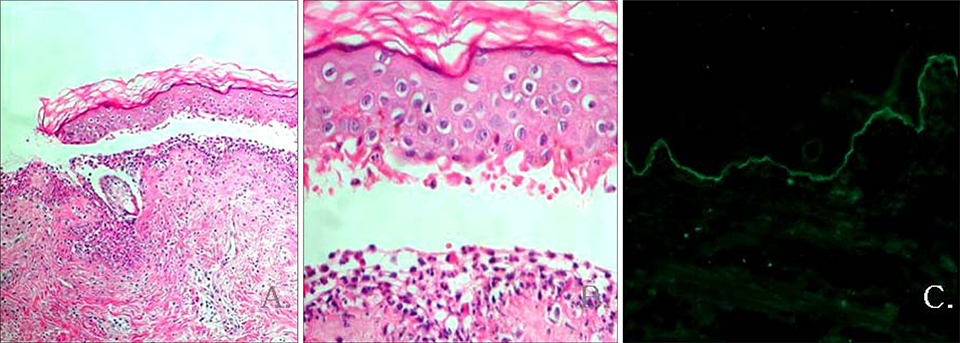Ann Dermatol.
2008 Jun;20(2):102-106. 10.5021/ad.2008.20.2.102.
Vancomycin-induced Linear IgA Bullous Dermatosis: A Case Report and Review of the Literature
- Affiliations
-
- 1Department of Dermatology, The Catholic University of Korea, Kangnam St. Mary's Hospital, Seoul, Korea. yymmpark@hotmail.com
- KMID: 2172095
- DOI: http://doi.org/10.5021/ad.2008.20.2.102
Abstract
- Linear IgA bullous dermatosis (LABD) is a rare autoimmune bullous disease that can either occur without any apparent cause or be induced by the administration of certain drugs, the most common of which is vancomycin. We present a case of a 45-year-old woman who was diagnosed with vancomycin-induced LABD by the presence of a characteristic linear band of IgA along the basement membrane zone on direct immunofluorescence microscopy. Our patient showed complete recovery after a 2-week period during which vancomycin administration was discontinued.
Keyword
MeSH Terms
Figure
Reference
-
1. Rao CL, Hall RP. Linear IgA dermatosis and chronic bullous disease of childhood. In : Freedberg IM, Eisen AZ, Wolff K, Austen KF, Goldsmith LA, Katz SI, editors. Fitzpatrick's dermatology in general medicine. 6th ed. New York: McGraw-Hill;2003. p. 587–592.2. Avci O, Okmen M, Cetiner S. Acetaminophennduced linear IgA bullous dermatosis. J Am Acad Dermatol. 2003; 48:299–300.3. Bachot N, Wechsler J, Demoule A, Roujeau JC. Amiodarone-related linear IgA bullous dermatosis. J Am Acad Dermatol. 2003; 49:E11–E12.
Article4. Cerottini JP, Ricci C, Guggisberg D, Panizzon RG. Drug-induced linear IgA bullous dermatosis probably induced by furosemide. J Am Acad Dermatol. 1999; 41:103–105.
Article5. Tran D, Kossard S, Shumack S. Phenytoin-induced linear IgA bullous dermatosis mimicking toxic epidermal necrolysis. Aus J Dermatol. 2003; 44:284–286.
Article6. Onodera H, Mihm MC Jr, Yoshida A, Akasaka T. Drug-Induced linear IgA bullous dermatosis. J Dermatol. 2005; 32:759–764.
Article7. Waldman MA, Black DR, Callen JP. Vancomycininduced linear IgA bullous disease presenting as toxic epidermal necrolysis. Clin Exp Derm. 2004; 29:633–636.
Article8. Jones DH, Todd M, Craig TJ. Early diagnosis is key in vancomycin-induced linear IgA bullous dermatosis and Steven-Johnson's syndrome. J Am Osteopath Assoc. 2004; 104:157–163.9. Armstrong AW, Fazeli A, Yeh SW, Mackoll BT, Liu V. Vancomycin-induced linear IgA disease manifesting as bullous erythema multiforme. J Cutan Pathol. 2004; 31:393–397.
Article10. Palmer RA, Ogg G, Allen J, Banerjee A, Ryatt KS, Ratnavel R, et al. Vancomycin-induced linear IgA disease with autoantibodies to BP180 and LAD285. Br J Dermatol. 2001; 145:816–820.
Article11. Chin HW, Jang HS, Jo JH, Kim MB, Oh CK, Kwon KS. A case of linear IgA bullous dermatosis probably caused by vancomycin. Korean J Dermatol. 2005; 43:416–418.12. Doh KS, Kim SH, Choi TS, Jang MS, Suh KS, Kim ST. A case of vancomycin-induced linear IgA dermatosis. Korean J Dermatol. 2002; 40:1132–1135.13. Zone JJ, Taylor TB, Meyer LJ, Petersen MJ. The 97kD linear IgA bullous disease antigen is identical to a portion of the extracellular domain of the 180kDa bullous pemphigoid antigen, BPAg2. J Invest Dermatol. 1998; 110:207–210.
Article14. Wakelin SH, Allen J, Zhou S, Wojnarowska F. Drug-induced linear IgA disease with antibodies to collagen VII. Br J Dermatol. 1998; 138:310–314.
Article15. Paul C, Wolkenstein P, Prost C, Caux F, Rostoker G, Heller M, et al. Drug-induced linear IgA disease: target antigens are heterogenous. Br J Dermatol. 1997; 136:406–411.
Article
- Full Text Links
- Actions
-
Cited
- CITED
-
- Close
- Share
- Similar articles
-
- A Case of Vancomycin-induced Linear IgA Bullous Dermatosis
- A case of Linear IgA Bullous Dermatosis Probably Caused by Vancomycin
- A Case of Linear IgA Bullous Dermatosis Probably Caused by Captopril
- A Case of Fulminant Linear IgA Bullous Dermatosis in an adult
- Vancomycin Induced Linear IgA Bullous Dermatosis



